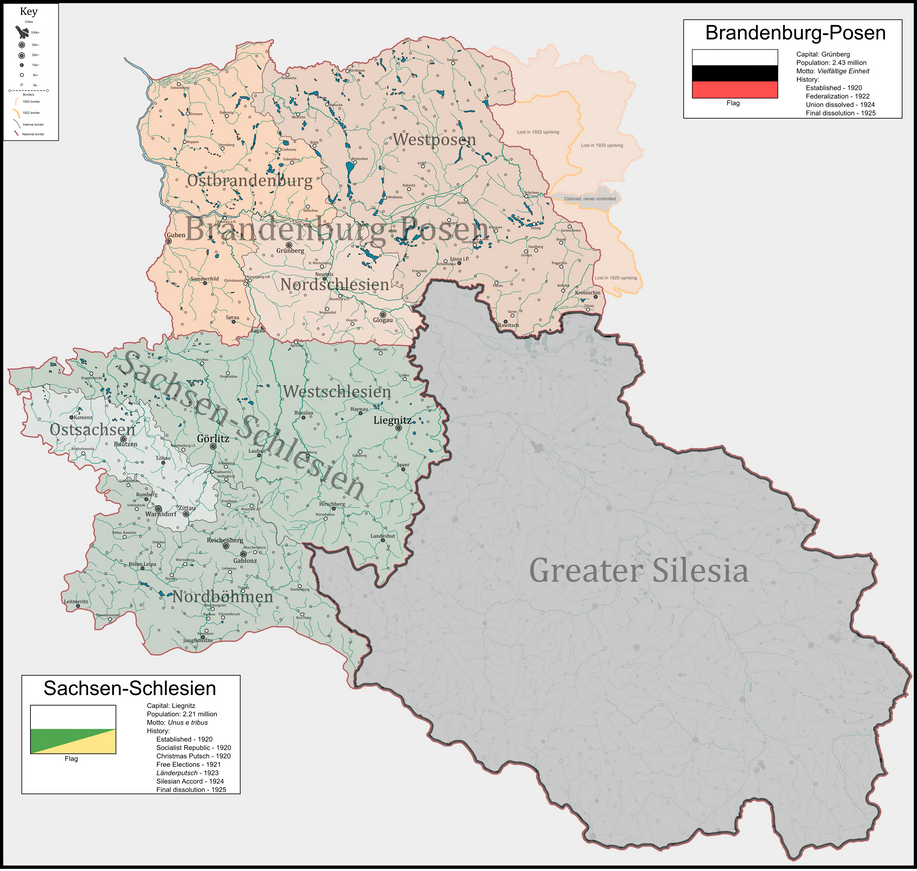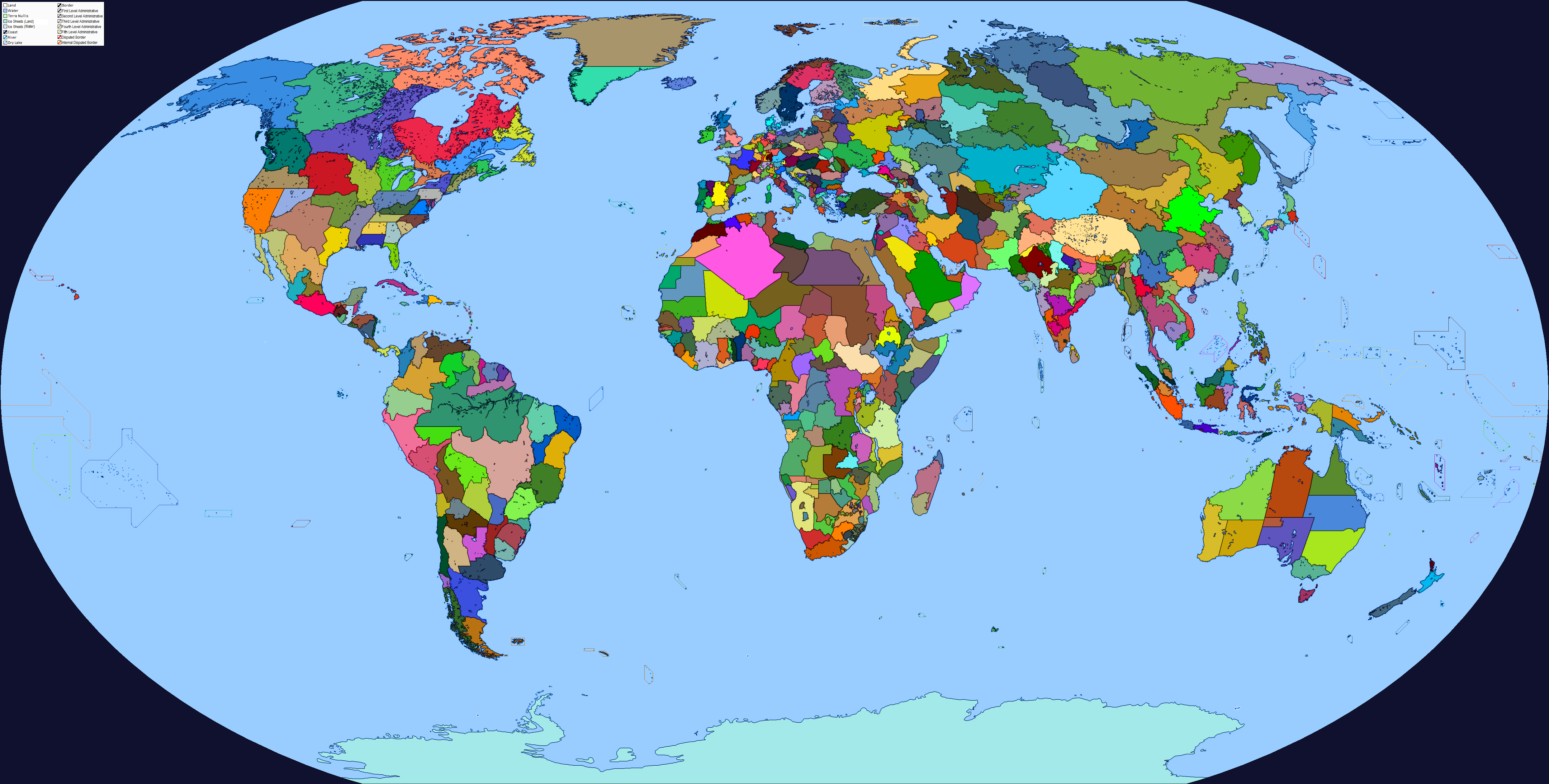This is the second part of A Right Reasonable Compromise, AKA me turning parts of my big map project into smaller maps that take place in an alternate post-WWI period. If you read the one about
Greater Silesia, you may notice that this has a significantly lighter tone.
I made a visualization of FSRD expansion into these states:
here.
---
Brandenburg-Posen
The competition for the title of "most troubled state to be created by the Amsterdam Peace Conference" was fierce, but many consider Brandenburg-Posen to be the prime candidate for the title. Established in 1920, it was originally meant to exist for roughly 5 years before a referendum would determine whether eastern Brandenburg (organized into the province of
Ostbrandenburg; East Brandenburg) would rejoin Germany; if it did, others would follow every two to three years for
Nordschlesien (Northern Silesia) and
Westposen (Western Posen). The fact that the date the first referendum was planned to be held on turned out to be after the country dissolved, only serves to highlight the rapidly-worsening state of the state.
Immediately following its founding, Brandenburg-Posen (B-P) faced an uprising in its eastern territories, as the local Polish majority expressed a strong desire to join Poland. After a series of civilized debates conducted using artillery, machine guns and rifles, it was determined that the Poles had a point, and they were allowed to join Poland. The following year, a new uprising erupted when the government in Grünberg decided that suppressing the use of the Polish language in public life would be a great method to increase stability. It failed, and instead increased the number of armed Polish men occupying important sites in Poznan (calling it 'Posen' was a poor idea at the time). In response, the barely-organized army of B-P was mobilized; a standoff began, between the Polish militias in the city and the numerically superior but poorly-motivated troops outside it.
The situation was quickly resolved when Poland offered to send a committee to investigate the precise events that had provoked the uprising in the city. This committee of experts was accompanied by a small force of guards to ensure their protection: 25,000 Polish soldiers, with a group of 200 freshly-purchased French Renault FT-17s at their head. The 15,000 Brandenburg-Posener troops agreed with the Poles that the situation was clearly under control, and proceeded to return home. The resulting political crisis within B-P led to a new constitution being drafted the following spring, creating the Federation of Brandenburg-Posen, which no longer contained the city formerly known as Posen (calling it Posen was still a bad idea).
The year of 1923 had a fairly calm start - after the political reorganization, the army reform and the eight-month process of building a new governmental coalition of the previous year, the only crises of note within the first three months were economic. Unfortunately, the declaration of bankruptcy in April, the collapse of the coalition and the ongoing lack of solutions to an entirely new problem (an army of 8,000 angry Saxo-Silesians occupying Glogau for a month and a half) led to a period of chaos that only ended when the western portion of the country, East Brandenburg, was occupied by the RVA and the FSRD (
Freie Sozialistische Republik Deutschland; Free Socialist Republic of Germany) demanded a dissolving of the federal union of Brandenburg-Posen.
In 1924, the union was officially dissolved, effectively recognizing the FSRD's annexation of East Brandenburg. It was only weeks later that the Silesian Accord was signed in Liegnitz, resulting in the RVA marching into the Sachsen-Schlesien province of
Westschlesien (West Silesia). The government in Grünberg was informed that the B-P province of
Nordschlesien (Northern Silesia) was included in the agreement by the helpful officers of the RVA, who then proceeded to arrest the entire government for a month before allowing them to leave to Rawitsch, in the province of
Westposen (Western Posen) to continue administering the remainder of Brandenburg-Posen, whose name was now even more ironic than before.
Not long after the government of the rump B-P arrived in Rawitsch, it became clear that their time in office was limited. The already-strained administrative apparatus of the country was falling apart, and effective control of much of
Westposen had now passed to local councils. These councils varied in character - some were anarchists intent on forming communes obligated to no authority, others socialists using the opportunity to redistribute the land of all the old Prussian nobles (who had a series of unfortunate accidents involving angry peasants, pitchforks and a surprisingly high number of rifle misfires), and several even called for the restoration of the old German Empire. It was a time of opportunity, anything seemed possible, especially if it involved a complete collapse of state institutions!
In 1925, the RVA marched into Rawitsch after occupying most of the rest of the country, which officially dissolved itself once a large enough crowd of parliamentarians was gathered to seem legitimate. The FSRD didn't take a clear stance on whether it accepted the territorial losses of Brandenburg-Posen, or if it would later demand a return to the 1920 borders.
---
Sachsen-Schlesien
While its northern neighbor was plagued by internal unrest,
Sachsen-Schlesien (Saxony-Silesia) was almost entirely free of that sort of internal dispute. Instead, it had political instability of another sort; after its establishment in 1920, the revolution washed across the border from Germany, and before long the "red tide" reached Liegnitz, followed by the declaration of the Socialist Republic of Saxony-Silesia. It was a short-lived affair, however, as only two months later the Christmas Putsch, carried out from the 24th to the 26th of December, ousted the socialist government. Agreements between the new FSRD and the signatories of the Amsterdam Treaty led to a withdrawal of revolutionary guard forces from Saxony-Silesia, and allowed for the right-wing forces to retake control of the country.
Only eight months later, in August of 1921, the first free elections of Saxony-Silesia were held. Pressured by the Amsterdam states and threatened by FSRD reprisal, the military government stepped down in response to their overwhelming defeat in the elections (the four parties supporting continued military rule or a continuation of their policies amassed only 13% of the vote). What followed was a period of attempted coalition-building between the various parties; left-wing votes were scattered across the
Partei der Schlesien Sozialisten (Party of Silesian Socialists),
Böhmische Sozialistenpartei (Bohemian Socialist Party),
Freie Arbeiterpartei Sachsens (Free Workers' Party of Saxony),
Sozialdemokratische Partei Sachsen-Schlesien (Social Democratic Party of Saxony-Silesia) and
Rätekommunistische Partei (Council-Communist Party), which followed similar goals but proved unable to form any larger coalition. The right was similarly splintered, between the monarchist fractions (
Hohenzollerntreue Bauernpartei [Hohzenollern-Loyal Farmers' Party],
Königliche Monarchistenpartei [Royal Monarchist Party] and various smaller parties), a conservative republican wing and the four parties supporting military rule.
In February of 1922, it seemed like the period without a government was over; a broad coalition of the more moderate portions of left-wing parties, a number of small centrist groups and the left-most conservative party formed. Together they managed to gain a minority large enough to function as long as they were tolerated by the other parties, and work when supported by additional votes from individual parties. This lasted until a scandal in July, involving the Minister of Finance, a case of jewels, and an escaped circus lion, which immediately destroyed the coalition and let to renewed political crisis. Calls for a new election grew louder until, in March of 1923, the so-called
Länderputsch took place.
The
Länderputsch ("Coup by the Federal States") was a move by the three federal states of Saxony-Silesia, in which the functioning state governments forcefully devolved various powers of the central government in order to secure the functioning of the state. This measure, supported by the military and broadly popular in the face of the continuous crisis of the previous year, resulted in a brief period of growth and stability for Saxony-Silesia. The economic crisis came to an end, rampant inflation successfully dealt with, and a series of policies enacted that combated social issues that had been left unattended since 1920. It also led to the cracking down on dissent within the military: once their control was secured, the states purged the more politically unreliable officers, eventually leading to a mutiny-turned-expedition in the north, which crossed into Brandenburg-Posen and occupied Glogau for 48 days before being driven out and disintegrating.
It was at the peak of this relative prosperity that the FSRD approached the (still headless) federal government with a demand. No longer constrained by the threat of action by the Amsterdam Treaty signatories, Berlin outlined a series of concessions that would effectively result in the dismantling of Saxony-Silesia in favor of a trio of states, each tied to Berlin and likely to be forcefully reintegrated in short order. Negotiations dragged on for months before an ultimatum spurred them into motion; the hopes of the Liegnitz government to establish a more favorable military and political situation had backfired, as the FSRD grew more confident after securing its hold on the newly-occupied eastern segment of Brandenburg and prepared its forces for a new advance. With no foreign aid available to Saxony-Silesia, the Silesian Accord was signed, giving the FSRD immediate rights to base troops in the region and arrange for reintegration at their leisure.
The federal government split into two groups, one heading to Bautzen and the other to Gablonz - the two capitals of the remaining federal states. Originally intended as a safety measure, to ensure that the FSRD could not easily capture the entire government in the case of treachery, it rapidly became the foundation for a new crisis. The local parliaments had little desire to re-establish a federal government; beyond the security of shared defense, and the benefits of a unified economic policy, Ostsachsen and Nordböhmen were hardly chomping at the bit to re-instate the parliamentarians who had failed to govern, and then signed away two-thirds of the country.
This crisis would be the last of Saxony-Silesia. As the collapsing remnants of Brandenburg-Posen were absorbed by the FSRD, the governments in Bautzen and Gablonz saw the writing on the wall. Plebiscites were arranged, to determine whether the remains of Saxony-Silesia would rejoin Germany. As the results came in, and the RVA took up positions on the border, the state of Saxony-Silesia was officially dissolved. 78.2% voted in favor of reunification in Ostsachsen, which negotiated a complex reintegration agreement with Berlin in the following months. In Nordböhmen, discrepancies in the numbers of votes received in various areas (one village of 3,219 people reported 18,000 votes in favor of the status quo, and another reported 0 votes in total, then the voting location burned down in a mysterious fire) and rising tensions led to the RVA crossing the border. The government in Gablonz protested the action, but when it came time to make a final decision, they chose to dissolve; remaining Nordböhmen military units stood down and were disarmed.
On November 22nd, 1925, Ostsachsen officially rejoined Germany, and the last of Saxony-Silesia vanished into history.



